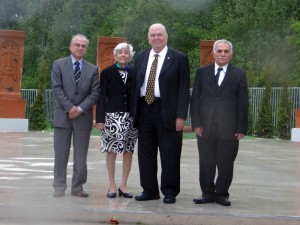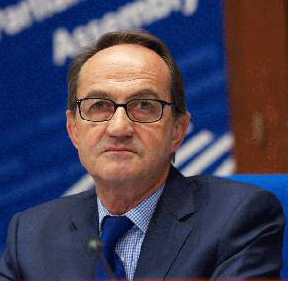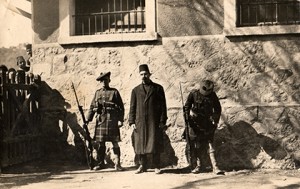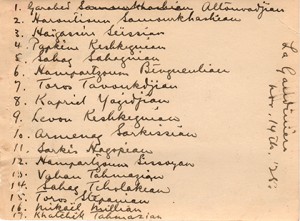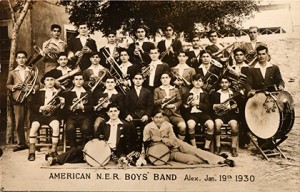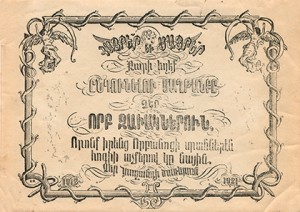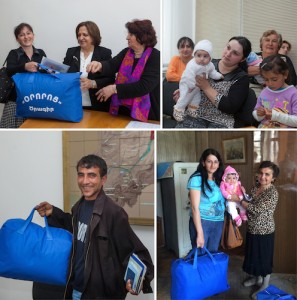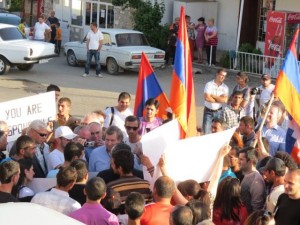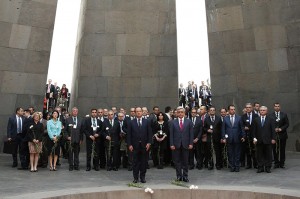UCLA—Professor Richard Hovannisian was invited to give keynote address at an international conference on the Armenian community of Lebanon. The Conference, organized by the Armenian Diaspora Research Center under the direction of Dr. Antranik Dakessian, took place on the Haigazian campus in Beirut from June 14 through 16.
The conference was opened by Haigazian President Reverend Paul Haidostian, who remained in attendance and participated throughout the proceedings. In his address, Hovannisian combined academic and personal elements, first by emphasizing the long history of the Lebanese Armenian community and its essential role in preserving and propagating Armenian language and culture throughout the entire diasporan world. The Lebanese community, together with the Syrian Armenian community, infused in young generations the concept of an imagined Armenia, without the normal detractive aspects that may be found in any actual state. That dedication and commitment to the ideal inspired and still continues to inspire the generations.
Professor Hovannisian then reflected upon the Lebanon that he discovered and which became his home for a year in the mid-1950s, with its Armenian-speaking population of all ages and its vibrant schools and institutions. There, he experienced for the first time Armenian as a living language, not just that of a generation of aging genocide survivors. Through a power point presentation, he captivated the audience by taking them back to the familiar sites of Lebanon before the tragic civil war in the 1970s and its regrettable massive exodus.
Papers during the three day conference were given by scholars from Lebanon, Syria, Armenia, Belorussia, France, and the United States. Hovannisian had the pleasure in the final session of moderating and commenting on a panel of talented, promising young Armenian scholars, whose research, data, organization and delivery were most impressive.
Prior to the Haigazian conference, Richard and Vartiter were in Belgium and the Netherlands for a series of talks. On May 9, an evening presentation was organized in the newly refurbished Hay Dun/La Maison arménienne in Brussels in a dinner program organized by a committee headed by Mr. Andre Gumuchdjian. On May 10, Hovannisian spoke in Amsterdam on the final stages of the Armenian Genocide up to the destruction of Christian Smyrna. The event was held under the auspices of the Abovian Society of Holland in the newly renovated historic Armenian Church of the Holy Spirit,. Mato Hakhverdian and Inge Drost served as the coordinators. The following day, May 11, Richard and Vartiter Hovannisian were in the Dutch town of Almelo, near the German border for a lecture following services in the Saint Gregory the Illuminator Church of the city, which has seen a large influx of Armenians from southeastern Turkey, Iraq, and Armenia. The community recently dedicated a large Armenian Genocide memorial on the large wooded property. Mr. Harout Palanjian of the Holland AGBU introduced the speaker, who was also welcomed by Armenia’s Ambassador to the Netherlands, the Honorable Dziunik Aghajanyan.
Flying from Beirut to Chicago on May 17, Richard and Vartiter Hovannisian went directly to a dinner reception at the spacious home of Mrs. Arpy Seferian as part of the Hairenik Association’s launch of its e-book series, starting with Voices from the Past. Introduced by Antranig Kasparian, Hovannisian reflected upon some of the titans whom he had come to know in his younger years, including Simon Vratzian, Dro Kanayan, Goms (Vahan Papazian), Garo Sassouni, Reuben Darbinian, the Patriarchs of Constantinople Karekin and Shnork, Locum Tenens of the Cilician Catholicosate Khat Achabayan, a young vartabed named Karekin, who would go on to become Catholicos, and His Holinesses Vazken, Zareh, and Khoren. In Chicago, too, Hovannisian showed power point images of Lebanon, when much of the intellectual and cultural life was still centered in West Beirut, and he offered a visual tour from the blue Mediterranean and the American University of Beirut through the bourg and souks, the shanty town of Karantina, Nor Hajin, Bourdj-Hamoud, Antelias, Bikfaya, and Anjar, which then was still dependent on kerosene lamps for lighting.
Richard Hovannisian will be in Watertown, Massachusetts on Saturday, June 14, under the auspices of the Armenian Library and Museum of Armenia (ALMA) to present his latest publication, Armenian Kesaria/Kayseri and Cappadocia. In Burbank, California on June 24, he will lead off a two-day Facing History and Ourselves teacher institute on the Armenian Genocide, and on June 25 he will offer his Kesaria presentation in the Glendale Public Library with the joint sponorship of the Nor Serount, Tekeyan, and Hamazkayin cultural associations and arrangements by Armenian Outreach Coordinator Elizabeth Grigorian.
Richard Hovannisian Delivers Keynote at Haigazian Conference in Beirut
